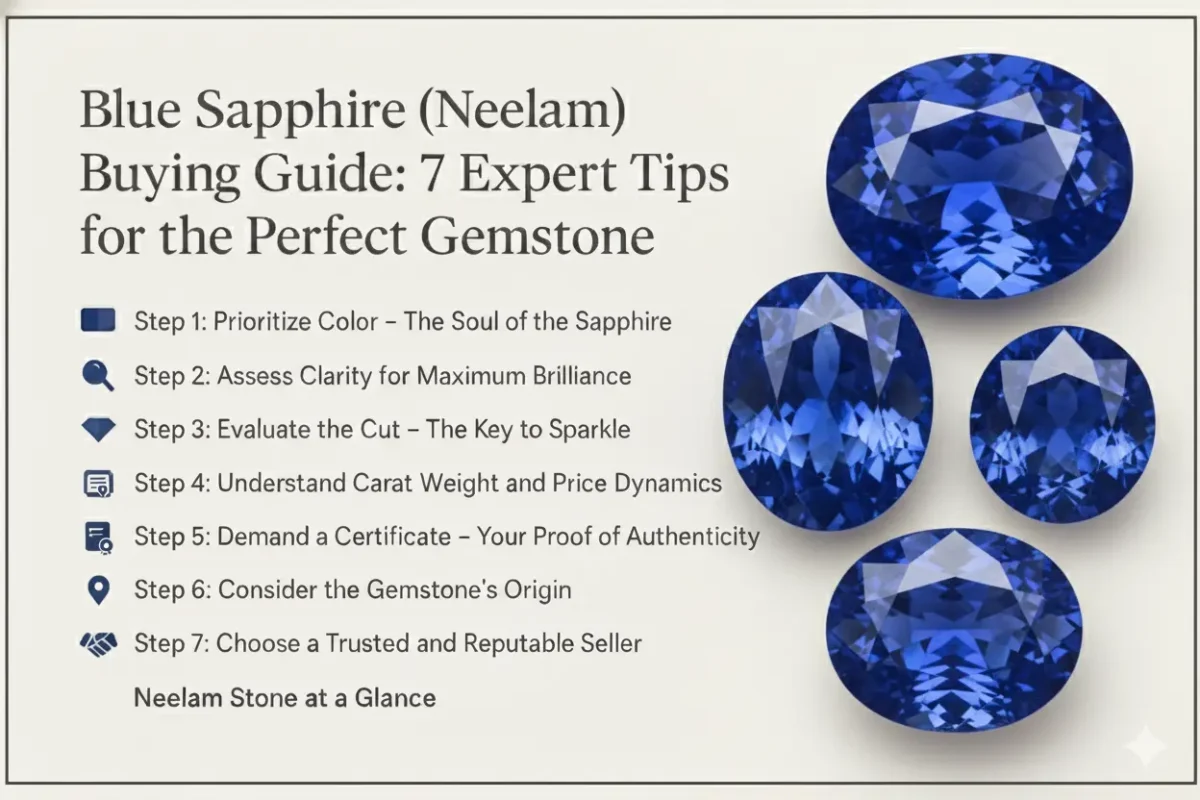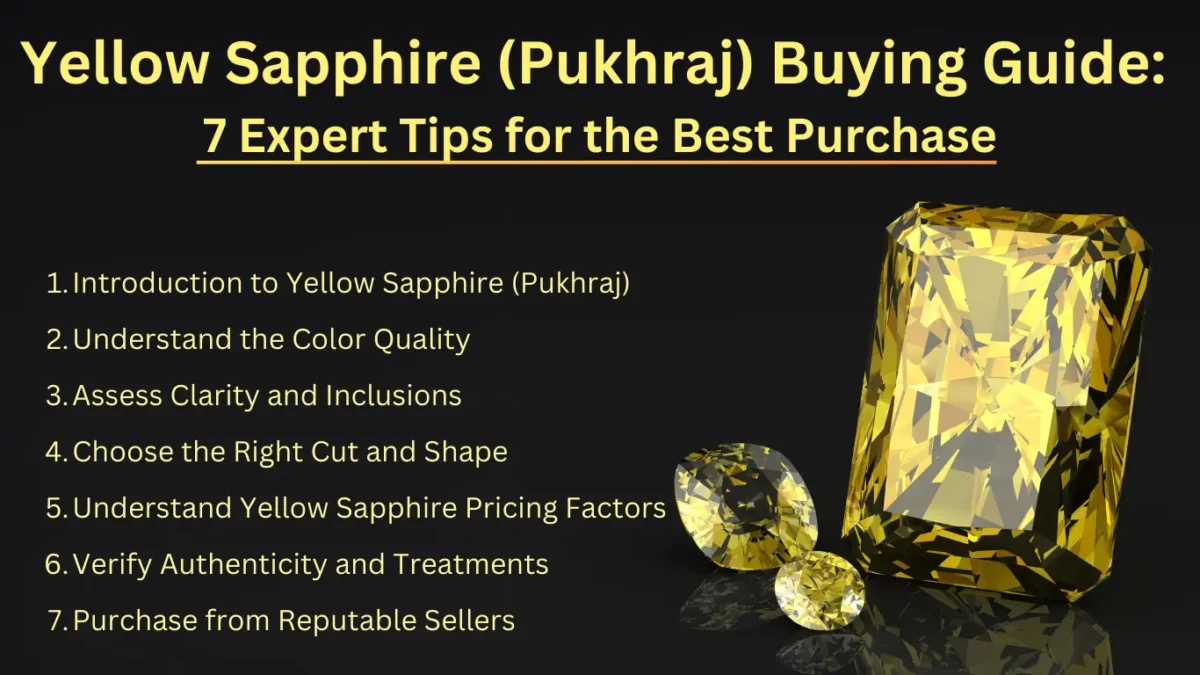Citrine (Sunela) Buying Guide: 7 Expert Tips for the Perfect Gemstone
Citrine, known in India as Sunela, is a gemstone that radiates the warm, joyful energy of the sun. As a variety of quartz, it is celebrated for its beautiful yellow to golden-orange hues and its association with prosperity and success. Often called “The Merchant’s Stone,” Citrine is a popular choice for attracting wealth and is also used as an effective astrological substitute (Upratna) for Yellow Sapphire. This expert guide provides in-depth knowledge on how to identify natural vs. treated stones, evaluate its quality, and buy an authentic Citrine with complete confidence.

Citrine (Sunela) at a Glance
| Gemstone Family | Quartz |
| Indian Name | Sunela |
| Astrological Role | Upratna for Jupiter (Guru) |
| Metaphysical Properties | Prosperity, Success, Joy, Creativity |
| Hardness | 7 on the Mohs Scale (Durable for jewelry) |
The Astrological Significance of Sunela and How to Wear It
In Vedic astrology, Citrine (Sunela) is a powerful Upratna used to harness the benevolent energies of the planet Jupiter (Guru), much like Yellow Sapphire (Pukhraj). It is worn to attract wealth, improve social status, and promote success in business and academics.
Astrological Rules for Wearing a Citrine (Sunela)
| Who Should Wear It? | Recommended for individuals seeking financial growth and wisdom. Especially beneficial for Sagittarius (Dhanu) and Pisces (Meena) ascendants. |
| Which Finger? | The index finger of the right (working) hand. |
| Best Metal? | Gold or Panchdhatu (a five-metal alloy) are the most recommended metals. |
| When to Wear? | On a Thursday morning during the Shukla Paksha (waxing moon phase). |
| Energizing Ritual (Prana Pratishtha) | Before wearing, the ring should be cleansed in Gangajal or raw cow’s milk and energized by chanting the Jupiter mantra “Om Gram Grim Graum Sah Gurave Namah” (ॐ ग्रां ग्रीं ग्रौं सः गुरवे नमः) 108 times. |
How to Buy an Original Citrine Stone: A Step-by-Step Guide
Step 1: Understand Natural vs. Heat-Treated Citrine
This is the most critical piece of knowledge for any Citrine buyer. The vast majority of Citrine on the market is not naturally occurring Citrine.
Crucial Information: Most commercial Citrine is actually heat-treated Amethyst or Smoky Quartz. When these stones are heated to high temperatures, their color changes to the golden-yellow and reddish-orange hues associated with Citrine. This is a stable and widely accepted industry practice.
- Natural Citrine: Is very rare. It typically has a pale, light yellow to smoky-yellow color. It is highly prized by collectors and is significantly more expensive.
- Heat-Treated Citrine: Has a more intense golden, reddish-orange, or brownish color. It is beautiful, affordable, and widely available.
Step 2: Understand Citrine Origins
While most commercial citrine is heat-treated amethyst (often from Brazil), natural citrine comes from specific locations.
- Brazil: The world’s largest producer of both natural citrine and amethyst that is heat-treated to become citrine.
- Bolivia: Famous for the Anahi mine, which produces a unique bicolor stone called “ametrine” that is part amethyst and part natural citrine.
- Madagascar & Russia: These regions are also known sources of high-quality natural citrine.
Step 3: Evaluate the Color
Whether natural or treated, color is the main value factor. The most desirable stones exhibit a deep, saturated color without any brownish or smoky tints.
Expert Insight: The most valuable color for heat-treated Citrine is a deep, reddish-orange, often sold under the trade name “Madeira Citrine,” named after the fortified wine of a similar color.
Step 4: Assess the Clarity
High-quality Citrine, both natural and treated, is typically “eye-clean,” meaning it has no inclusions visible to the naked eye. As a type of quartz, clean material is abundant, so there is little reason to purchase a stone with visible flaws.
Step 5: Examine the Cut and Shape
A well-executed cut is essential to maximize the brilliance and sparkle of a Citrine. A good cut will ensure the stone reflects light evenly and shows off its beautiful color. Citrine is available in all shapes and sizes, making it a very versatile gemstone for designers.
Step 6: Verify Authenticity
The main challenge is not distinguishing Citrine from fakes like glass, but understanding whether you are buying a natural or a heat-treated stone. A certificate from a reputable gemological laboratory is the only way to be certain of a stone’s natural origin.
Step 7: Purchase from a Reputable Seller
Always buy from a trusted dealer who is transparent about their products. A reputable seller will always disclose if a Citrine is heat-treated (which is standard practice) and will be able to provide a certificate for rare, natural stones.
Why Trust Ratna Gems™ for Your Citrine?
At Ratna Gems™, we are committed to providing authentic, high-quality astrological gemstones with complete transparency. We are your trusted source because we offer:
- Certified Authentic Citrine: Every Sunela stone is certified by a recognized lab and comes with a Lifetime Authenticity Guarantee.
- Transparent and Honest Pricing: We offer competitive prices for genuine Citrine with full disclosure on quality and treatments.
- Unmatched Customer Support: Our experts are here to guide you, and our 7-day return policy ensures your complete satisfaction.
Frequently Asked Questions
Is most Citrine just burnt Amethyst?
Yes, the vast majority of commercial citrine available today is heat-treated amethyst or smoky quartz. This is a permanent and stable treatment that is widely accepted in the gem trade. Natural, unheated citrine is very rare and typically has a much paler yellow color.
Is heat-treated Citrine still effective for astrology?
Yes. As an Upratna (substitute gemstone), heat-treated Citrine (Sunela) is widely used and accepted in Vedic astrology to harness the benefits of Jupiter. Its energetic properties are considered effective even after treatment.
What is Madeira Citrine?
Madeira Citrine is a trade name for Citrine that has a deep, saturated, reddish-orange color, similar to Madeira wine. It is the most valuable and sought-after color for Citrine.
How should I care for my Citrine jewelry?
Clean your Citrine with warm, soapy water and a soft brush. While it is a durable stone, it is still best to protect it from harsh chemicals and scratches by storing it separately.






Leave a Comment
You must be logged in to post a comment.